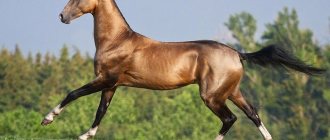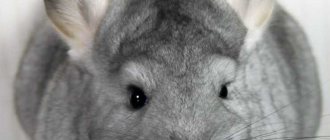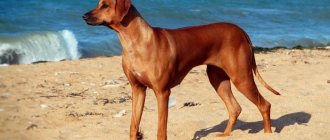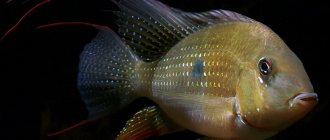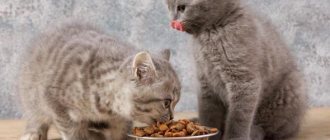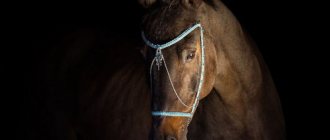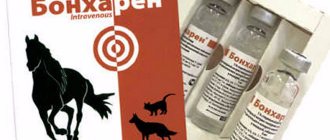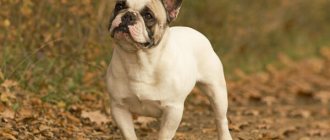Description and features of the suit
There is still debate about the origin of the concept of “brown suit”. It is widely believed that the name is associated with the word “brown”, which, in turn, comes from the Turkic “Kara”, which means “black”. However, there are doubts about the correctness of this theory, because the brown color cannot be called dark.
The horse's brown color was formed under the influence of the Dun gene, which colors the animal's coat a bright sandy shade. Depending on the activity of other genes, color saturation varies. The legs and head of a brown horse are always darker than the body. Color anomalies are not uncommon for such horses:
- Dark spots on the body and limbs.
- A long strip along the ridge.
- Black “stockings” from the hooves to the knee joint.
- Transverse stripe in the withers area.
- Horizontal stripes on the front legs (which resembles the color of a zebra).
Some characteristics make the brown color similar to the mousey or savage shade. However, there is a significant difference - brightness, saturation of the main tone.
Types of colors
Since brown horses can be light or dark, they are usually classified. Animals of this color can be divided into 3 types:
- Dark brown. These horses are characterized by a dark red body color. The head and lower limbs are several shades darker. The main distinguishing feature is a brown stripe along the spine. The tail and mane combine hair of reddish, brown, light beige shades.
- Brown - the red tone predominates. The body is colored slightly lighter than the muzzle, limbs, mane and tail.
- Light brown. The head and legs are darker than the body color; the mane and tail contain light and red shades. Such horses are characterized by spots of light brown or reddish color.
Bay color
The bay color of the horse implies a brown body color. The same is true of wild horses. Accordingly, bay horses are close to them genetically. This is what is associated with the unpretentiousness and endurance of brown horses. They are the fastest, because in nature you often have to run away from predators and pursuers.
Natural selection gave the bays excellent health. Confirmation of this is the record holder among horses for life expectancy. His name is Billy. The gelding from Cleveland lived 62 years, with the average horse age being a quarter of a century.
They did not stand on ceremony with the gelding Billy. Until the end of his days and from a young age, the horse towed barges along the shore. This confirms the endurance of bays. It’s not for nothing that there is another record among them. We are talking about the most expensive stallion. His name is Frenkel. The horse costs 200 million dollars. The average cost of a horse is 5 thousand conventional units.
One of the most common horse colors is bay.
The bay color has 8 strokes. It's easy to imagine dark and light brown, bay, golden, chestnut and cherry. Two more names require decoding.
Bay-chestnut horse color
Underhair horse
The last bay option is the horse's karak color. The term is taken from Turkic. There “kara-kul” means “black-brown.” This is the essence of the name. The color of horses is characterized by a dark brown body and black legs, tail, and mane.
Karak horse
Wild horses are black with brown undersides. Domestic bays also have lighter limbs. They are white on a brown background. In adulthood, this coloration is rarely preserved. With age, the legs darken.
Young bay foals, on the contrary, have lighter limbs
Bay-piebald horse
Characteristics of horses with this color
Due to their impressive physical strength, brown-colored animals are used in agriculture. They are rarely selected to participate in exhibitions and competitions and riding.
Despite the fact that brown horses have an easy-going, calm disposition, in case of danger they can always stand up for themselves. It is not for nothing that in Russian folklore wild horses of this color were attributed to stubbornness, willfulness and disobedience.
When purchasing a horse, you should remember that this animal cannot stand loneliness and requires regular “communication”. This also applies to horses of brown color. If it is not possible to maintain a large herd, a good option would be to buy other farm animals, such as goats or sheep - this is enough to create “company” for the horse.
The lifespan of such horses is 25–30 years, depending on the breed and the conditions created. With proper care, animals grow up to 2 meters at the withers, and weight varies from 400 to 1,000 kg.
Varieties of gray color
Gray
The gray color of a horse or gray color appears in an adult. Over time, during the molting process, the gray color becomes more pronounced. Although initially the foal could have been born black. After a couple of months, light villi appear. A year later, the same foal will acquire a light color. An individual with discolored, almost white hair is called light gray. At the same time, the gray horse looks white.
Albino
Albino
Albino is a rare phenomenon. This is a snow-white horse, blue-eyed or brown-eyed with pinkish skin. Unlike light grays, albinos are born white.
Spreading
In Russia and the countries of the former USSR, the brown color is found in the following breeds:
- Altai.
- Kazakh.
- Yakutskaya.
- Soviet heavy truck.
In Europe, this coloring is typical for Icelandic horses and the Norwegian Fjord breed. On other continents it is more difficult to see animals of such colors - they are bred artificially or imported from European countries. A striking example is the American mustangs, which owe their appearance in Latin America and the United States to the Spanish conquerors.
Suit Spread
Horses of brown color are rare in the modern world.
For example, in Russia brown horses are usually found in local breeds:
- Kazakh
- Yakutsk
- Altai
And others like that. Sometimes the brown color appeared in Soviet draft breeds, in various crosses.
In America, brown horses are found among breeds such as the mustang, appaloosa and criolo - they were originally originally from Europe, they were brought to America by the Spanish conquistadors.
Care instructions
The basis of the diet of brown horses is oats and hay, which, if necessary, is replaced with straw without harm to the animals. In summer, horses spend maximum time on pastures, where they feed on their own. During the cold season, the amount of food should be increased so that the animal’s body retains heat.
Attention! Horses constantly need to drink, so it is important that the animal always has access to clean water.
Regular physical activity is considered a vital necessity for brown horses - this is especially true in winter, when the animals are not free to range. Make sure your daily walks take at least 3-4 hours.
Horses of brown color
Domestic horses also require regular cleaning, washing, and checking their hooves—the health of the animal depends on this. It is especially important to pay attention to the mane, which protects the horse’s neck and head from insect bites. Another mandatory condition is to examine the horse’s teeth. It is recommended to perform this procedure once every 6 months.
What suits are there?
Suit is a hereditary factor. Among the many shades and colors, experts identify 4 fundamental suits:
The brown horse is considered one of the varieties, the prototype of the reddish color . This is a wild color that existed in nature, the color of the ancestors of the modern horse.
This color is found in different breeds; weight, height, and other characteristics depend directly on the breed and proper care.
The better the content, the larger the horse. A horse can weigh from 0.5 to 1 ton. The Altai brown horse does not grow higher than one and a half meters and weighs 500 kg, the heavy brown horse grows up to 2 meters and weighs about a ton.
What is brown color?
According to the research of scientists, we owe the term “kauriy” to the language of the Turks. It is based on the word “kovur”, meaning brown color. Moreover , it is the Turkic peoples who hold the palm in taming representatives of wild herds.
It is believed that this color is the result of mutation processes, therefore it is extremely rare in comparison with other “wild colors”: mousey, savras.
The tones of this color may differ due to the mixing of fur hairs of different tones. The brown color is very similar to the reddish color; accordingly, it is characterized by bright red shades, interspersed with reddish-red wool in the form of a strip along the ridge, reminiscent of a belt. The presence of stripes darker than the rest of the color on the joints is allowed. This distinctive feature is called zebraing.
All “wild colors” are characterized by darkened wrists, mane and tail, close in color to brown tones. As for the groin area, abdomen, muzzle, these are more lightened areas, thanks to the lightening gene DUN, it is able to act only on certain areas of the body. In the wild, this color allows the horse to hide perfectly and provides excellent camouflage in the natural environment.
In spring and summer the color is more saturated, from autumn to the end of winter it is lighter.
In old age, the brown horse begins to turn gray quite actively, and the color fades.
Brown suit colors
It is assumed that this color appeared as a result of a mutation, and therefore is much less common than the other two “wild” colors (saurus and mouse). In a horse of this breed, the shades depend on the mixing of hairs of different colors.
The brown color has brighter reddish tones and there is always the presence of a red-red “belt” in the form of a dark stripe running along the ridge.
There may be dark brown stripes on the hocks, the so-called “zebra stripes.” Like all wild colors, their tail, mane and wrist area are darker, reddish-brownish, which is why they are also called red-savras. But the area of the abdomen, groin, muzzle and eyelids are painted in lighter shades.
This coloring is an excellent camouflage and allows animals to remain unnoticed for a long time. In the winter season the color is lighter, and in the summer it is richer. Over time, older individuals acquire a lighter color and “grey.”
We invite you to familiarize yourself with: Cirneco dell'Etna Sicilian Greyhound
Did you know? The brown color preceded the bay shades and is the main color of the Przewalski's horse. These odd-toed ungulates have two fewer chromosomes than domestic varieties, which does not prevent them from successfully interbreeding and reproducing, which is not surprising, since the domestic horse and the Przewalski's horse belong to the same species - Equus ferus.
The described suit is presented in several variants.
- The body of darkish-brown individuals has a dark red color. The head and lower limbs are darker. The stripe next to the ridge is chocolate. There are dark red and dark brown strands in the mane and tail. “Zebra” (stripes on the legs) is brownish.
- Brown representatives have a light red body, a red head and a dark red mane and tail. The “strap” (on the ridge) and the stripes at the hock joint are reddish-brown.
- Light brown horses have a light body against a darker head. The mane and tail have red and blond hair. “Zebra” and “belt” are of a reddish hue. This variety is practically not found at hippodromes or exhibitions; their destiny is in agriculture.
These are the main colors of the brown suit of horses.
Possible shades
There are several varieties of brown color, which depend on the tones of the coat color .
- Dark brown . Representatives of this color are distinguished by a dark red tone in the area of almost the entire body. The darkest shade of reddish is observed on a certain head part and limbs. The belt stripe near the ridge has a chocolate tint. The tail and mane include red and red shades with dark tints. In addition to this expressive color scheme of the body, there is zebra-shading and a small number of dim brownish spots in the area of the shoulder blades.
- Light red. The color of the body is a light reddish color; it is noteworthy that the head, mane, and tail are quite rich red. Zebra stripe, a belt stripe of a deeper red color with a brown tint.
- Light kauraya. This coloring is notable for the lightened part of the body, while the color of the head is darker, but in the same range. The mane and tail consist not only of red hair, but also very light hair, so the adjacent parts of the body look somewhat darker. Zebra stripes, stripes, spots have a pronounced red tint. This type of horse is most often presented at exhibitions, thematic forums and competitions at the hippodrome. In addition, there is an active use of these types of horses in agriculture.
How is color formed?
The brown color of a horse is formed by diluting the red color with gray. The Dun gene in the red color is responsible for its manifestation. This diluent gene is also responsible for the appearance of other "wild" colors, but only in black or bay mares.
The Dun gene is an example of classic incomplete dominance - it has greater substitution power compared to "gray apples" or cream coloring. The presence of this gene determines the “wild” color of the horse with the replacement of the main color (in this case, red) with a grayish one.
Horses of brown color are characterized by the following features:
- black stripe of hair along the back;
- horizontal stripes (zebroid) on the forelimbs;
- “stockings” of black color up to the hock (less often the knee) joint;
- transverse stripe in the withers area.
The brown color is considered a sign of a primitive, wild horse. This is due to rock paintings, where horses were depicted with a brown color. But it is worth noting that among the tarpans and Przewalski horses, the color is not often found. Also, as a result of paleontological studies, the brown color was practically not identified among the representatives of the ancestors of modern horses.
The most common horses in nature are mousey and brown-colored. Przewalski's horses, currently living in Mongolia, have coats of these shades. The tarpans that once inhabited the forests and steppes of Europe and Asia, which disappeared at the beginning of the 20th century, were also Savras. Most researchers associate the appearance of the brown color with other ancestors of the domestic horse, which gave a wide variety of modern colors.
Brown color is one of the types of “wild” horse colors characteristic of the ancestors of modern domestic horses.
Formation of kaura suit:
- the Extentition gene (responsible for the presence of black pigment in the hair) must be recessive homozygous - her;
- the Agouti gene (replaces black color with white hair) can be in any position;
- The Dun gene (responsible for lightening the coat) can be recessive or dominant.
In the western foothills of Norway, short, but strong and hardy horses are bred. The breed is considered one of the oldest in Europe and was used as a basis for improving imported animals. A distinctive feature of the breed is that all horses are carriers of the Dun gene.
The Fjord horse has a distinct appearance, combining draft qualities with maneuverability and mobility - local breeders have been striving for a long time to preserve all the useful qualities of the horse with their maximum impact. Exterior Features:
- the neck is massive, strong, curved;
- head of medium size with a wide frontal part, straight profile;
- the ears are small, the eyes are large, expressive;
- the body is compact, muscular;
- limbs are strong, strong;
- the mane is large and long, but most livestock breeders trim it, leaving a small brush;
- height at the withers – 135-150 cm;
- live weight – 400-500 kg;
- balanced temperament.
Currently, dark-colored Fjord horses are becoming less and less common - most representatives are homozygous for the dominant Dun gene. Therefore, brown (as well as savras and mouse) coloring is included in the mandatory standard for the Norwegian breed. All horses in this group are characterized by “wild” colors with black stripes on the body and limbs.
The Norwegian Fjord horse is considered one of the oldest breeds in the world. It is assumed that horses came to Scandinavia in the 4th millennium BC and subsequently developed without the infusion of blood from outside. Therefore, the Norwegian breed is also considered the “purest”. This is indirectly confirmed by the presence of gray color dilution gene in all representatives.
Active selection and use of the Norwegian horse occurs in the Christian era. Fjord horses plowed the land, transported heavy loads and sat on horseback. The breed thrives in harsh northern and mountainous conditions. The massive use of horses continued after World War II.
We suggest you read: How much does it cost to keep a horse per month?
Breeds
Most often, representatives of the brown color are related to the steppe. This color is common in large percentages among such representatives:
- Altai;
- Yakut;
- Bashkir;
- Kazakh;
- Soviet heavy truck is a very rare phenomenon.
Brown color can never be seen among horses. As for European breeds, the most common color is among the large Irish Connemara ponies; the Fjord heavy horses of Norway also have a similar color, although more lightened. On the American continent, brown color is found in mustangs. In addition to those listed, brownness is found in many mixed American-Spanish breeds:
Very often, brownness is observed precisely in those breeds that occurred as a result of crossing domestic horses with wild representatives of the breed.
This color itself is rare and is related to wild colors. Therefore, brownness can only be observed in those breeds whose ancestors included wild horses.
Brown horses
Everyone has heard a huge amount of information about such varieties as the black, bay, red, gray horse. But few people know about such a species as the brown color of the horse. This type of color cannot be called common, since many people know nothing at all about it. But in fact, the brown horse is the wildest species of animal, because the color itself is close to the aboriginal type.
Brown horse color
Diet
Everyone knows that the horse is a herbivore animal. Therefore, the diet mainly consists of grass or hay, oats. Oats are easily replaced with straw. In the summer, horses graze on the grass and provide themselves with food, the volume of which reaches 100 kg for each individual.
In winter, you need to provide the horse with hay, and he needs more nutrition than in summer so that he does not freeze.
Of course, the animal needs to drink a lot of water. The volume of liquid consumed can reach more than 60 liters per representative.
The origin of brown color and its features
Brown color is considered a rather rare type of horse coat color and is found in zonal or wild colors. Modern horses received the kaurasti shade by inheritance from distant ancestors who inhabited the planet many millions of years before the appearance of man. Kaurasti arose due to the influence of the DUN gene, the so-called wild color gene, on the hair pigment. Horses that have this gene are considered the oldest. They are usually called “wild colors”. What makes DUN unique is that it is based on a red color and has a brightening effect. It affects the black and red pigment of the coat at the same time, but does not lighten the entire coat.
The mane, tail and lower limbs are not susceptible to bleaching. The coloration of a horse, which is based on the DUN gene, is an excellent camouflage in any terrain and makes it possible to go unnoticed, which is of great importance for the preservation of populations. It is worth noting that horses that have the “wild gene” have common color features.
The coat of the head and body consists of mixed hairs of different colors, giving the overall tone of the horse, and is duller in relation to the mane and tail. The body of the zonal suits itself is colored unevenly. There are clearings in the areas of the eyes, throat, abdomen, as well as in the groin areas and buttocks. The head and neck of the animal are several shades darker than the body. The lower parts of the limbs are dark or black. All wild colors have primitive markings. One of the main distinguishing features, inherited from a distant relative of the tarpan, is the dark transverse stripes located in the hock area. They are usually called “zebrastiness”.
Another distinctive feature appears as a dark brown or black stripe running along the horse's spine (the "strap") and darkening on the horse's shoulder blades. Thanks to the above characteristics, the zonal suits are combined into one, which is called Savrasaya and is divided into the bulano-savrasaya, bay-savrasaya, raven-savrasaya (mousy) and red-savrasaya (brown) suits.
A horse of brown color has a light red or, more precisely, faded body color . The color of the head and legs is a more saturated shade than the main one. The mane and tail consist of a mixture of strands of dark brown, dark red and light colors, and are the brightest parts of the hairline. As for primitive markings, the belt has a red-brown or dark red color. And the horizontal stripes located in the area of the hock joint are marked with a brown tint. Over the years, all horses turn gray. Color saturation, becoming duller. The brightness of the coat is also affected by the seasons. It gets brighter in winter and darker in summer.
The shades of the coat of brown horses can be either very light or very dark, which as a result leads to the following division:
- Dark brown color of the horse. The body is dark red in color. The head and lower parts of the limbs are several shades darker. The stripe running along the ridge is dark brown. The mane and tail consist of dark red, dark brown and light strands and are the darkest parts of the horse's hair. Zebra and minor spots on the shoulder blades are brown.
- Brown horse color. The body is light red in color. The head and lower parts of the legs are red. The animal's tail and mane are dark red. The strap and horizontal stripes located in the hock area are reddish-brown.
- Light brown color of the horse. The body is very light. The head and lower parts of the limbs are slightly darker than the main part. As a rule, the mane and tail consist of a mixture of red and blond hair and, compared to the general background, appear to be the darkest parts of the horse's hair. Zebra, belt and partial darkening of the light brown color of the horse are red or light brown.
Suit overview
Before we talk about the features of the brown color, it should be said in general that among all horses there are main and also additional colors. The main ones include four types: black, bay, red, gray. All other horse colors are considered derivative. But there is a separate type called "wild" or "zonal" suits. They are characteristic of wild horses, as well as representatives of local aboriginal breeds.
Since all “zonal” colors have many common features, they are usually united under a common name - savrasaya. However, they all still differ from each other, so they are named with the prefix of the main color. For example, among such suits they distinguish between mouse, brown and savras. They are also called raven-savrasaya, red-savrasaya and bay-savrasaya.
Interesting! The main suits, according to geneticists, come from Savras, and not vice versa.
General features of “wild” horses
As we have already said, all three types of color have common features. So, in horses with this color, the main part of the body has a basic tone. But the mane, tail and lower parts of the limbs are colored darker. In this case, motley hairs and strands may be present throughout the body. It is also necessary to have clear spots in the muzzle area, on the stomach, around the eyes, on the buttocks and in the groin.
It's all in the genes
The brown color, like the savra and mousey ones close to this type, is determined by the special Dun gene. This gene is also called the “wild color gene” because it was passed on to modern horses from their ancestors. However, not all animals can inherit this color, but only those closest to the wild genotype. Today, for example, Przewalski's horses are like this, as in the photo. Also, “brownness” appears among modern breeds, for example, in some draft horses and local horses.
Many people confuse the actual savras and red-savras colors of horses. Yes, their differences are hardly noticeable, unlike the mouse ones. The main secret of recognition is the saturation of the fundamental tone. Everything where there is a brighter yellowish tint is called brown color. A pale shade of fur with a large number of dark strands and hair in the mane and tail speaks of pure savagery.
Features of the offset
The brown color is possible only when the Dun gene is combined with the main gene responsible for the red color. That is why such horses have a red main coat color and are called red-savras. Only in the abdomen, under the chest, as well as on the muzzle and around the eyes, lighter hair appears. At the same time, the tail, mane, and legs remain darker in color, reaching red-red. These parts of the body can also be light if the modifier gene is active.
Brown horses are encouraged to have so-called “wild” markings. This is a dark stripe along the ridge, zebra stripes on the legs, and also a transverse stripe on the withers (like donkeys). In addition, this color allows for a wide variety of basic shades among different breeds. For example, Przewalski's horses have a rich reddish-yellow body, as in the photo. But the Norwegian fjords are characterized by a lighter sandy shade.
Variety of shades
Although at first glance it may seem that this type of brush-off always has the same tone, this is not entirely true. Among the red-brown animals, various shades are also distinguished. For example, a dark brown horse has a base dark red coat color with all other "zonal" color features. A regular redhead is a light red base hair color with a dark mane, tail and limbs. The light shade is very close to salty in combination with other signs of savageness.
Where is it found?
Brown color, as you already understood, is a very rare type of horse color. Few breeds can have it. As a rule, these are local horses that were formed by crossing wild ones with domestic ones. For example, in our country such an unusual color is found among Altai, Kazakh, Yakut and some other aboriginal breeds. Sometimes this type of savrasity manifests itself in.
As for other countries, in Europe Icelandic ponies, Connemara ponies, as well as representatives of the Norwegian Fjord breed have a red-brown color. In America, this color is characteristic of mustangs, quarter jockeys, appaloosa and criollo breeds. See photos of these horses below.
Recommendations
When purchasing a horse, you must take into account that this is a herd animal. He does not like to be alone and always needs “company”, this also applies to the brown color of the horse. Not many people can afford to own several horses, but by purchasing a few more sheep or goats, you will create excellent company for your pet.
Since the horse is a herbivore, its diet consists of hay and oats, but if necessary, hay can always be replaced with straw. In the summer, the horse grazes on pasture and consumes up to 100 kg of grass during the day (depending on the age of the horse). In winter, she needs more food to keep warm. The amount of food per day depends on her age and body weight. But, like a person, she needs to drink more, so she needs to consume up to 60 liters per day.
The horse needs special attention and care. The main need is physical activity. In the summer she spends most of her time on the pasture, thereby walking herself. But in winter he is in a stall and needs exercise. This walk should take 3-5 hours a day. The second necessity is cleaning the animal. Living in the wild, the horse cleans itself by rubbing it on the ground. But domestic horses need brushing, washing the entire body and inspecting the hooves 1-2 times a day, it all depends on the time of year, living conditions and physical activity. The condition of the mane directly affects the well-being of the animal, since the mane performs a protective function, protecting the neck and head from insects. Therefore, horse owners must keep the mane in order. The same applies to the horse’s teeth; it is recommended to check them every six months. And also the shoeing of the horse’s hooves, shoeing should be carried out every month and a half
Sources:
https://fermhelp.ru/kauraya-mast-loshadi/ https://stroy-podskazka.ru/loshadi/porody-i-masti/kaurye/ https://moiloshadki.ru/kauraya-mast-loshadi-opisanie- foto/
Suit concept
First you need to understand what a suit is. Coloring is determined at the genetic level and is considered a distinctive feature of an individual. It includes the color of the hair on the head and body, as well as a combination of eye and skin shades. No discrepancies are allowed. That is, a black horse cannot have a white mane, and a red horse cannot have black legs. In addition to suits, shades are distinguished - colors.
The formation of the coat occurs along with the growth of the foal. It will be different in an adult. A horse is born, for example, red with whitish hairs around the eyes. The mousey foal moults and becomes black. At the age of six months, the baby's fur is replaced with a permanent one. The gray color is revealed later - the horse becomes “buckwheat” or dapple gray.
In addition to color, horses have markings - spots of different shapes and sizes, located on the head or limbs. The foal is born with these spots.
All available horse colors are divided into 4 groups:
- bay;
- Gray;
- Voronaya;
- Redhead.
When analyzing what other horse colors there are, we should mention non-basic colors, which are also called colors or derivatives. They were given names by people far from genetics, so there are many classifications.
It is worth noting that there is no white suit. Most often it is a black and white or red and white horse. White is considered to be a discolored gray or albino. White horses have poor health.
